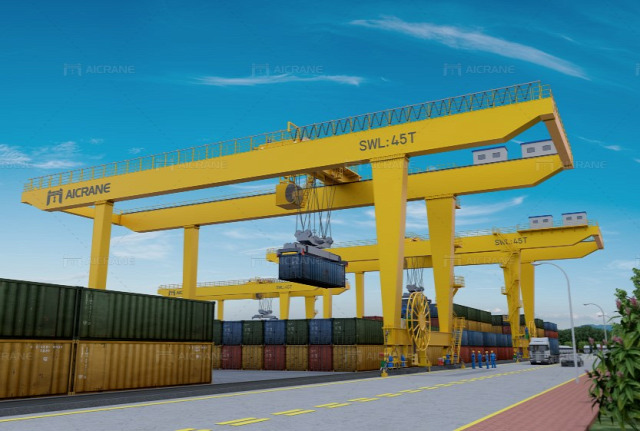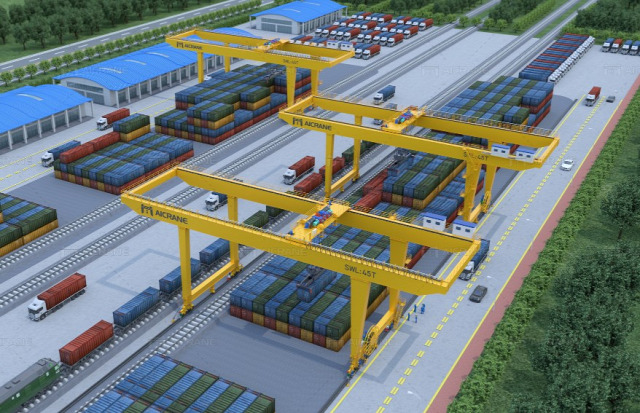Container terminals are at the heart of global trade, handling millions of containers that move goods across continents. As demand for faster, more efficient shipping grows, the role of equipment such as gantry cranes becomes increasingly critical. Gantry cranes, particularly Rail Mounted Gantry (RMG) cranes and Rubber Tyred Gantry (RTG) cranes, are essential in improving the speed, efficiency, and safety of container handling operations in terminals.
In this article, we explore how container gantry cranes improve efficiency in container terminals, focusing on their technological advancements, operational advantages, and impact on productivity.

The Role of Gantry Cranes in Container Terminals
Gantry cranes are indispensable in container terminals due to their ability to lift, move, and stack containers efficiently. These cranes are designed to operate over a large span, which allows them to work over rows of containers or directly over rail lines. There are two main types of gantry cranes commonly used in container terminals:
-
Rail Mounted Gantry (RMG) Cranes: These RMG cranes operate on rails and are primarily used in intermodal terminals where they load and unload containers from trains or trucks. RMG cranes are known for their precision and are typically used in stacking areas where they can handle high container volumes with minimal downtime.
-
Rubber Tyred Gantry (RTG) Cranes: Unlike RMG cranes, RTGs are mobile and equipped with rubber tires, making them more versatile. They can move containers across the terminal and are often used for stacking containers in storage areas. RTG cranes are popular due to their flexibility and ability to handle uneven terrain.

How Gantry Cranes Improve Efficiency in Container Terminals
1. Increased Loading and Unloading Speed
One of the most significant ways gantry cranes improve efficiency is by increasing the speed at which containers are loaded and unloaded. Whether it is from a ship, truck, or railcar, these cranes are designed to handle large volumes of containers quickly. The ability to stack containers in multiple rows and tiers means more containers can be processed in less time, reducing vessel turnaround times and terminal congestion.
For example, an RMG crane, which operates on a rail system, can unload containers directly from trains and place them in stacking areas or onto trucks for further transportation. The automation capabilities of modern RMG cranes allow for swift, precise movements that minimize the time it takes to handle each container. Similarly, RTG cranes are equipped to handle fast, seamless container movements across various parts of the terminal.
This speed not only enhances throughput but also optimizes the terminal’s overall efficiency, enabling operators to process more shipments in a given period.
2. Optimized Space Utilization
In container terminals, space is always at a premium. With increasing global trade volumes, terminals must maximize their available space to store and handle more containers. Gantry cranes play a key role in this by enabling high-density stacking.
RMG and RTG cranes can lift containers and stack them in several tiers, allowing operators to store more containers in a given area without expanding the terminal footprint. RTG cranes are particularly useful in tight spaces because their mobility allows them to move containers efficiently between different sections of the terminal.
In addition to vertical stacking, modern gantry cranes use advanced software and control systems to optimize container placement. These systems ensure that containers are placed in the most efficient locations based on their departure or retrieval schedules, reducing unnecessary movements and improving container access.
3. Enhanced Precision and Control
Gantry cranes are equipped with advanced technologies that enhance their precision and control. In modern container terminals, precision is vital for maximizing operational efficiency. Cranes equipped with advanced control systems, such as GPS and automation software, can precisely position containers with minimal human intervention.
For instance, anti-sway technology stabilizes the container during lifting and lowering, reducing the time needed to position it accurately. This precision leads to fewer operational delays and reduces the risk of accidents, as containers are moved smoothly and safely.
Moreover, RMG cranes, which often operate in automated environments, can function with minimal human supervision. Automated cranes can work around the clock, further improving terminal efficiency by maintaining consistent container handling rates even during off-peak hours or at night.
4. Automation and Integration with Terminal Management Systems
The integration of automation technology in gantry cranes has been a game-changer for container terminal efficiency. Automation reduces human error, improves operational consistency, and allows cranes to work more quickly and efficiently than manual systems.
Automated gantry cranes, particularly RMG cranes, can be integrated with terminal operating systems (TOS) to synchronize container handling with other terminal operations. This integration allows for real-time tracking of container locations, movements, and loading schedules. As a result, terminal operators can optimize container flow, reduce bottlenecks, and ensure that containers are handled and dispatched efficiently.
Additionally, automated cranes can operate continuously without the need for breaks, further enhancing throughput and reducing labor costs.
5. Reduced Fuel Consumption and Environmental Impact
Efficiency in container terminals isn’t just about speed and space—it’s also about minimizing costs and environmental impact. Gantry cranes, particularly RTGs, have seen significant improvements in terms of energy efficiency and sustainability.
Hybrid and fully electric RTG cranes have been developed to reduce fuel consumption and carbon emissions. By replacing traditional diesel-powered engines with electric motors or hybrid systems, terminals can significantly lower their environmental footprint. These energy-efficient cranes also reduce operational costs by minimizing fuel consumption and maintenance expenses.
Furthermore, regenerative braking systems installed on some cranes can recover energy during braking, which can then be used to power other terminal equipment or systems, further improving energy efficiency.
6. Increased Safety
Safety is a critical concern in container terminals, where large, heavy containers are constantly being moved. Gantry cranes come equipped with a range of safety features that reduce the risk of accidents, protecting both personnel and equipment.
Modern cranes use collision avoidance systems, load monitoring technologies, and automated controls to ensure safe operation. Sensors and cameras provide operators with real-time data on crane positioning, container weight, and nearby obstacles, allowing them to prevent accidents before they occur.
By enhancing safety, gantry cranes reduce the likelihood of costly disruptions, protect workers, and contribute to the smooth operation of the terminal.
The Future of Gantry Cranes in Container Terminals
As global trade continues to expand, container terminals will face increasing pressure to handle more cargo faster and more efficiently. Gantry cranes will continue to play a central role in meeting these demands. The future of gantry cranes will likely see further advancements in automation, energy efficiency, and safety, allowing terminals to operate with even greater precision and lower environmental impact.
In the coming years, the adoption of fully automated container terminals—where all crane operations are automated—could revolutionize the industry. These terminals would rely entirely on RMG cranes and other automated machinery to handle containers, further enhancing speed, accuracy, and cost-effectiveness.
Conclusion
Gantry cranes have transformed the way container terminals operate, making them more efficient, safer, and better equipped to handle the growing demands of global trade. By increasing loading and unloading speeds, optimizing space utilization, and integrating advanced automation, gantry cranes enable terminals to process more containers in less time while reducing costs and improving sustainability. As the technology behind these cranes continues to evolve, their role in driving container terminal efficiency will only become more vital.

